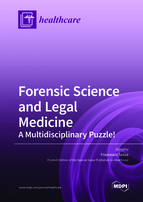Forensic Science and Legal Medicine: A Multidisciplinary Puzzle!
A special issue of Healthcare (ISSN 2227-9032). This special issue belongs to the section "Forensic Medicine".
Deadline for manuscript submissions: closed (31 December 2021) | Viewed by 59720
Special Issue Editor
Interests: genetics and molecular biology; forensic and biological sciences; forensic genetics; genomic physiology; aging and genetics; pharmacology; toxicology; health professions; translational pharmacology; biochemistry
Special Issues, Collections and Topics in MDPI journals
Special Issue Information
Dear Colleagues,
Even if the terms “forensic sciences” and “legal medicine” seem to be synonymous, they could be defined as two sides of the same coin. It has been demonstrated that they are different components of the application of medical knowledge upon the legal system. Legal medicine has greater relevance to civil and tort law, impacting upon patient care, whereas forensic medicine relates to criminal law and damage to (or by) patients.
The discipline of forensic science is remarkably complex and includes methodologies ranging from DNA analysis to chemical composition and pattern recognition. Many forensic practices were developed under the auspices of law enforcement and vetted primarily by the legal system rather than being subjected to scientific scrutiny and empirical testing. Furthermore, the recent experience of the COVID-19 pandemic suggests a pivotal role of the forensic autopsy in order to gather information about unknown diseases. As previously described, only a full autopsy can investigate the potential mechanisms of damage to organs or systems not readily accessible to biopsies, such as central nervous system or cardiovascular system, leading to appropriate health-care strategies that are useful in the control of the disease. Another important perspective that underlines the importance of forensic sciences is related to the development of vaccine candidates and new therapies for the prevention and treatment of different diseases, with certain benefit for healthcare.
Furthermore, legal medicine plays a pivotal role in risk management. In healthcare, the term “risk management” refers to all processes employed to detect, monitor, assess, mitigate, and prevent risks in healthcare facilities and safeguard patient safety. Considering the importance of this issue, a further aim of this Special Issue is to assess the role and progress of research and training in the field of risk management.
Given the importance of the topic, the journal Healthcare is launching a Special Issue entitled “Forensic Science and Legal Medicine: A Multidisciplinary Puzzle!” with the aim of gathering accurate and up-to-date scientific information on all aspects of this theme, collecting original investigations, case series and case reports, and reviews in all forensic and medico-legal branches. Particularly, this Special Issue aims to provide an overview of recent technological advances in all fields of the forensic and medico-legal sciences, such as forensic pathology, anthropology, criminalistics, digital and multimedia sciences, engineering and applied sciences, pathology/biology, psychiatry and behavioral science, jurisprudence, odontology, risk management, questioned documents, and toxicology.
Similar submissions dealing with forensic aspects of other sciences and the social sciences are also welcome, as are submissions dealing with scientifically sound emerging science disciplines.
Dr. Francesco Sessa
Guest Editor
Manuscript Submission Information
Manuscripts should be submitted online at www.mdpi.com by registering and logging in to this website. Once you are registered, click here to go to the submission form. Manuscripts can be submitted until the deadline. All submissions that pass pre-check are peer-reviewed. Accepted papers will be published continuously in the journal (as soon as accepted) and will be listed together on the special issue website. Research articles, review articles as well as short communications are invited. For planned papers, a title and short abstract (about 100 words) can be sent to the Editorial Office for announcement on this website.
Submitted manuscripts should not have been published previously, nor be under consideration for publication elsewhere (except conference proceedings papers). All manuscripts are thoroughly refereed through a single-blind peer-review process. A guide for authors and other relevant information for submission of manuscripts is available on the Instructions for Authors page. Healthcare is an international peer-reviewed open access semimonthly journal published by MDPI.
Please visit the Instructions for Authors page before submitting a manuscript. The Article Processing Charge (APC) for publication in this open access journal is 2700 CHF (Swiss Francs). Submitted papers should be well formatted and use good English. Authors may use MDPI's English editing service prior to publication or during author revisions.
Keywords
- Forensics Sciences
- Autopsy
- Forensic pathology
- Forensic toxicology
- Forensic genetics and genomics
- Postmortem investigation
- Technology and forensics
- Genomic application in forensic sciences
- Risk management
- Legal medicine







